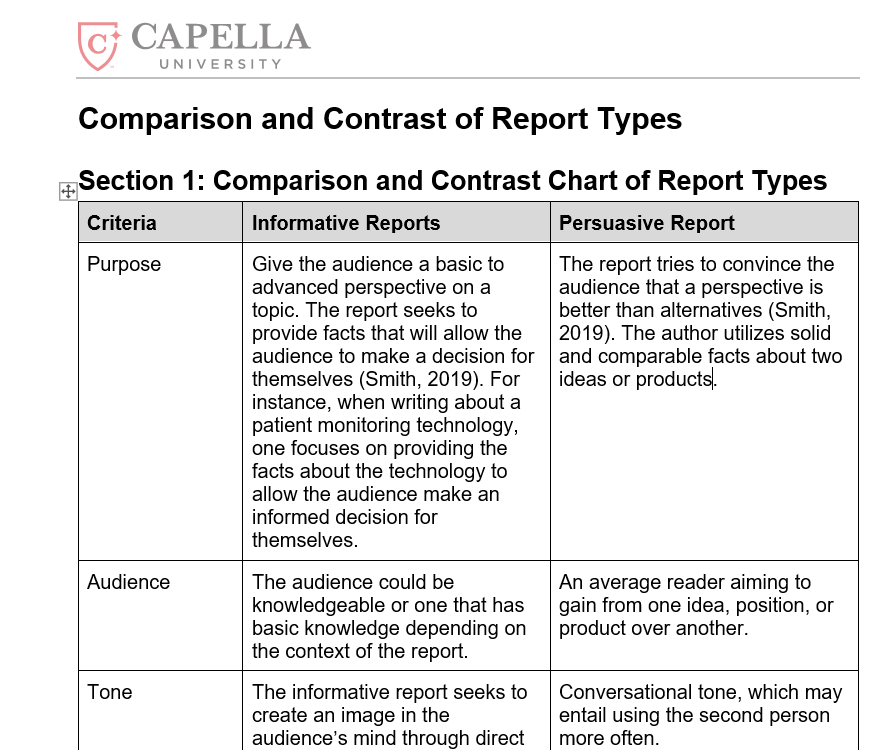Comparison and Contrast of Report Types
Capella University
ENG-FPX1250: Introduction to Technical and Business Writing
Dr.
July 20, 2023
Comparison and Contrast of Report Types
Section 1: Comparison and Contrast Chart of Report Types
| Criteria | Informative Reports | Persuasive Report |
| Purpose | Give the audience a basic to advanced perspective on a topic. The report seeks to provide facts that will allow the audience to make a decision for themselves (Smith, 2019). For instance, when writing about a patient monitoring technology, one focuses on providing the facts about the technology to allow the audience make an informed decision for themselves. | The report tries to convince the audience that a perspective is better than alternatives (Smith, 2019). The author utilizes solid and comparable facts about two ideas or products. |
| Audience | The audience could be knowledgeable or one that has basic knowledge depending on the context of the report. | An average reader aiming to gain from one idea, position, or product over another. |
| Tone | The informative report seeks to create an image in the audience’s mind through direct and concise writing. | Conversational tone, which may entail using the second person more often. |
| Formatting | Informative reports follow a general format of an introduction, body, and conclusion (Smith, 2019). The introduction presents the topic while the body describes the facts. The conclusion wraps facts. | A persuasive report has standard format. The initial paragraph is the introduction. The second, third, and fourth paragraphs provides details of the body including major arguments of the report (Smith, 2019). The last paragraph is the conclusion that summarizes arguments expressed in the report. |
| Style | Simple, concise, and easy to read and navigate. | Justifications, arguments, and reasons make the audience agree points in the report. |
| Writing conventions | The author has to make assumptions that the audience is not as knowledgeable on the topic as they are. Correct scientific, technical terms, and labelled diagrams necessary. | Sound reasoning, focus on details, and adequate consideration of alternatives. |
| Other names by which this type of report is known | Explanatory, instructive, educative | Compelling, convincing, argument essay |
Section 2: Explain the Uses of Informative and Persuasive Reports
A. When to Use the Informative Report
Informative report provide information in an organized and objective manner. The goal is to increase the audience’s knowledge, help readers to understand procedures and processes, and increase understanding of an issue (Amsalem, 2019). The data-driven nature of the report makes them appropriate for addresses processes or functions that could help increase operational efficiency, reduce errors, and optimize quality and safety metrics. For example, an informative report may provide insights into internal inefficiencies that hinder patient care. The report may include details about the need for a well-organized workforce to achieve consistent performance and enhance success of the organization.
B. When to Use the Persuasive Report
Authors should use persuasive report to convince the audience to agree with a certain perspective (Amsalem, 2019). For example, one may consider a persuasive report on the need for the government to regulate all fast-food chains in a country. The report provides insights into the health implications of the businesses and the impact of a decision to reduce individuals’ exposure to fast foods. The goal is to present logical arguments and offer a conclusive resolution
References
Amsalem, E. (2019). How informative and persuasive is simple elite communication? Effects on like-minded and polarized audiences. Public Opinion Quarterly, 83(1), 1-25. https://openscholar.huji.ac.il/sites/default/files/eran.amsalem/files/amsalem_2019.pdf
Smith, J. (2019). Communication @ work. Seneca. https://pressbooks.senecacollege.ca/buscomm/

